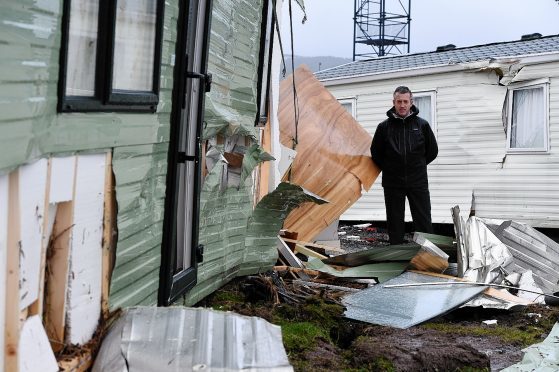Aberdeenshire Council is facing a £7.6million repair bill in the aftermath of Storm Frank.
Homes, roads, bridges and caravan were damaged or washed away by the worst flooding to hit the region in living memory.
Now councillors are being asked to approve a total £4.2million worth of funding to fix council houses, roads, bridges and other infrastructure.
However, questions were asked last night where the remaining £3.4million will come from – with opposition councillors criticising the administration for not setting up a flood resilience fund as suggested during budget talks earlier this month.
On Thursday, members of the policy and resources committee will be asked to approve using £3million from the council’s winter and other emergencies fund for remedial works to help get the region back on its feet.
They will also be asked to back spending £1.2million on bringing 22 council homes in Ballater – which are currently being stripped and dried out – back into use.
The authority is currently in talks with the Scottish Government about securing financial support from the Westminster under the Bellwin Scheme.
It is also seeking specific funding from Holyrood, in addition to the £2million handed to the council in January.
The River Dee was the first to burst its banks on December 30, with heavy rainfall leading to the rivers Don, Ury and Ythan also overflowing in the following weeks.
Some 600 homes and 100 businesses were devastated by the floods.
Jim Gifford – head of opposition group Aberdeenshire Alliance – said securing the full £7.6million for repairs was a “concern” and questioned where the outstanding cash would come from.
He said a “safer” option would have been to allocate a specific flood fund from a budget overspend.
“We always knew there was going to be a huge cost, which is why we suggested back in policy and resources in January to set up a community resilience fund to pay for things like this, rather than dipping into other funds that are for clearing snow and ice,” Mr Gifford said.
“We suggested using an underspend to pay for storm damage. That was just under £4million. We put it into our alternative budget but it was not accepted either.”
But council co-leader Richard Thomson – vice-chairman of the policy and resources committee – defended the recommendation, and said situations such as this is exactly what the winter and emergencies fund is for.
He added: “The New Year flooding was clearly an exceptional series of events which affected Aberdeenshire. It’s important to consider where the financial resources to meet that challenge will come from, and that’s what this report does.
“Our existing winter maintenance and other emergencies fund is meant to cover situations exactly like the one we currently face.
“Taken together, this reserve, alongside the council’s insurance, the additional monies which will be coming from the Scottish Government as well as our existing budgets and reserves, will allow us to do all that we need to.
“As a council, we have been able to meet the financial demands placed upon us to date by the flooding and its aftermath.”
Chairman of the policy and resources committee and fellow co-leader, Martin Kitts-Hayes, said: “Obviously it gives an idea how much the council has had to spend in terms of the flood damage, which is obviously a lot of money.
“We are committed to helping people as much as we can. Clearly that money is not in the budget and we have to fund it from resources. It is the right thing to do.”
The report to policy and resources states a flood recovery group has been established by the council which has been
calculating the costs of the repairs, and highlights that £1.7million has already been spent on repairing some of the damage.
